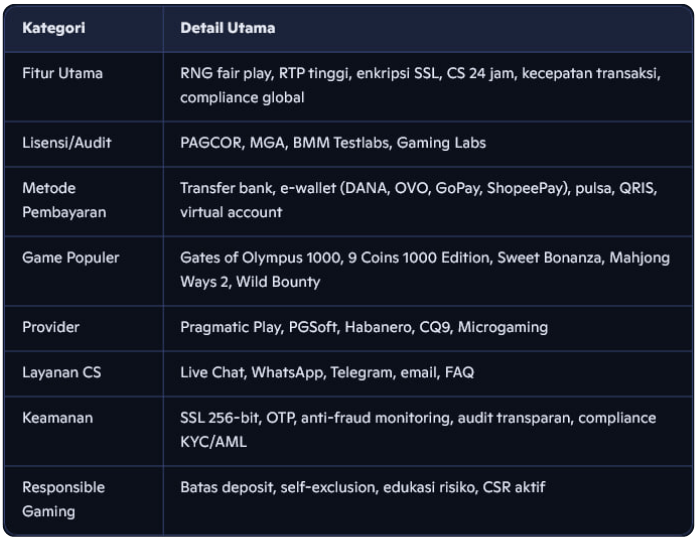Di tengah pesatnya pertumbuhan industri hiburan digital, Sakti55 menegaskan posisinya sebagai situs slot online terpercaya yang paling dicari tahun 2025. Platform ini bukan sekadar tempat bermain, melainkan ekosistem hiburan digital yang mengedepankan fitur inovatif, sistem fair-play, dan peluang jackpot besar. Dengan akses resmi melalui domain expressnewstimes.com, Sakti55 menghadirkan pengalaman login game seru yang aman, stabil, dan bebas hambatan.
Reputasi Sakti55 dibangun di atas fondasi keamanan data, keadilan permainan, dan transparansi transaksi. Sistem fair-play yang diterapkan, didukung oleh sertifikasi RNG dan audit RTP dari lembaga internasional, memastikan setiap pemain memiliki peluang menang yang setara. Tak hanya itu, peluang jackpot dengan konsep multiplier dan winrate tinggi menjadikan Sakti55 sebagai gudang jackpot yang selalu ramai diburu para pemburu cuan.
Sakti55 juga dikenal luas berkat layanan pelanggan 24 jam, kecepatan transaksi 2–5 menit, serta metode pembayaran lengkap mulai dari transfer bank, e-wallet, hingga pulsa. Semua fitur ini didukung oleh lisensi resmi dari otoritas global seperti PAGCOR, MGA, BMM Testlabs, dan Gaming Labs, menegaskan legalitas dan kredibilitas brand di mata pemain Indonesia.
Kenapa Harus Sakti55: Pentingnya Akses Resmi dan Ancaman Link Palsu
Hanya Domain expressnewstimes.com yang Asli dan Aman
Di era digital yang penuh risiko, akses ke situs resmi menjadi kunci utama keamanan akun dan dana pemain. Sakti55 menegaskan bahwa hanya domain expressnewstimes.com yang merupakan jalur login resmi dan aman. Mengakses situs melalui link palsu atau domain tiruan sangat berbahaya, karena berpotensi menjadi korban phishing, pencurian data, atau penipuan saldo.
Maraknya situs palsu yang meniru tampilan Sakti55 menjadi ancaman nyata. Modus penipuan digital seperti phishing kerap menyasar pemain dengan mengirimkan link serupa, hanya berbeda satu huruf atau menggunakan domain aneh. Jika terkecoh, data pribadi, password, bahkan saldo akun bisa dicuri dalam hitungan detik. Oleh karena itu, verifikasi domain dan pastikan selalu login melalui link sakti55 adalah langkah wajib sebelum bermain.
Sakti55 menjaga reputasinya dengan sistem keamanan berlapis, audit transparan, dan komitmen anti-fraud. Brand ini telah membangun kepercayaan publik melalui layanan konsisten, payout lancar, serta testimoni positif dari ribuan member aktif. Dengan lisensi internasional dan audit rutin, Sakti55 membuktikan diri sebagai platform yang tidak hanya legal, tapi juga benar-benar aman dan kredibel.
Keunggulan dan Fitur Utama Sakti55
Sakti55 menawarkan fitur-fitur unggulan yang menjadikannya solusi login game seru paling dicari tahun 2025. Berikut adalah rangkuman fitur utama yang membedakan Sakti55 dari situs slot online lain:

Setiap fitur di atas dirancang untuk memaksimalkan kenyamanan, keamanan, dan peluang menang bagi seluruh member. Sistem RNG dan RTP tinggi memastikan tidak ada manipulasi, sementara enkripsi SSL dan monitoring anti-fraud menjaga data tetap rahasia. Layanan CS 24 jam siap membantu segala kendala, mulai dari klaim bonus hingga troubleshooting teknis.
Game Seru Paling Dicari Tahun 2025: Jackpot Multiplier dan Sensasi Maxwin
Konsep Jackpot Multiplier dan Cara Kerjanya
Salah satu daya tarik utama Sakti55 adalah konsep jackpot multiplier yang mampu mengubah kemenangan kecil menjadi payout fantastis. Fitur multiplier bekerja dengan mengalikan nilai kemenangan berdasarkan angka tertentu, misalnya 5x, 10x, hingga 1000x. Jika pemain menang Rp100.000 dan mendapatkan multiplier 10x, maka total payout menjadi Rp1.000.000.
Multiplier bisa muncul secara acak, melalui simbol khusus (Wild/Scatter), atau diaktifkan saat bonus round seperti Free Spins. Beberapa game bahkan menawarkan progressive multiplier yang terus meningkat selama sesi bonus, menciptakan peluang jackpot yang benar-benar besar.
Ilustrasi Nominal Kemenangan
Sebagai ilustrasi, pada game Gates of Olympus 1000 dari Pragmatic Play, pemain bisa meraih kemenangan hingga 15.000x taruhan dalam satu spin beruntung. Jika bertaruh Rp10.000, potensi maxwin mencapai Rp150.000.000. Game lain seperti 9 Coins 1000 Edition juga menawarkan multiplier dan jackpot progresif yang sering tembus ratusan juta rupiah.
Game Populer dan Sensasi Gudang Jackpot
Sakti55 dikenal sebagai gudang jackpot berkat koleksi game populer seperti Gates of Olympus 1000, 9 Coins 1000 Edition, Sweet Bonanza, Mahjong Ways 2, dan Wild Bounty Showdown. Setiap game dirancang dengan RTP tinggi, volatilitas menantang, dan fitur bonus yang memacu adrenalin. Sensasi spin, suara efek kemenangan, dan animasi multiplier membuat setiap sesi bermain terasa hidup dan penuh harapan.
Jenis Permainan Lengkap di Sakti55: Slot, Live Casino, Sportsbook, Togel
Sakti55 menghadirkan varian permainan terlengkap untuk memenuhi selera semua kalangan:
- Slot Online: Ratusan judul dari provider premium seperti Pragmatic Play, PGSoft, Habanero, CQ9, Microgaming. Tersedia mode demo gratis untuk latihan tanpa risiko.
- Live Casino: Baccarat, roulette, blackjack, dragon tiger, dan game show dengan live dealer profesional. Streaming HD, interaksi real-time, dan suasana kasino autentik.
- Sportsbook: Taruhan olahraga sepakbola, basket, tenis, e-sports dengan odds kompetitif dan pasaran lengkap. Fitur live betting dan statistik real-time.
- Togel Online: Pasaran resmi Hongkong, Singapore, Sydney, dan lainnya. Proses betting transparan, result update cepat, payout tinggi.
Provider yang bekerja sama dengan Sakti55 semuanya telah berlisensi internasional dan rutin diaudit untuk memastikan fairness serta payout yang adil. Fitur demo slot memungkinkan pemain mencoba strategi tanpa modal, sementara live casino menghadirkan sensasi kasino sungguhan langsung dari layar gadget.
Strategi Bermain & Tips Jackpot 2025: Volatilitas, RTP, dan Disiplin Modal
Cara Membaca Volatilitas dan RTP
Memahami volatilitas dan RTP (Return to Player) adalah kunci strategi bermain slot modern. RTP menunjukkan persentase teoretis pengembalian ke pemain dalam jangka panjang, sedangkan volatilitas menggambarkan seberapa sering dan besar kemenangan yang mungkin didapat. Slot volatilitas tinggi seperti Gates of Olympus 1000 menawarkan payout besar namun jarang, cocok untuk pemburu jackpot. Slot volatilitas rendah lebih sering menang kecil, cocok untuk bermain santai.
Tips Bermain Disiplin dan Mengatur Modal
- Tentukan batas modal sebelum bermain dan patuhi dengan disiplin.
- Bagi modal ke beberapa sesi agar peluang bertahan lebih lama.
- Manfaatkan bonus dan promosi untuk menambah saldo bermain.
- Pilih waktu spin potensial, misal saat traffic rendah atau event bonus berlangsung.
- Gunakan mode demo untuk latihan strategi tanpa risiko kehilangan uang.
Menekankan RNG dan Fairness
Penting untuk dipahami, slot online modern menggunakan RNG (Random Number Generator) bersertifikat yang membuat setiap hasil spin benar-benar acak dan tidak bisa diprediksi atau diatur polanya. Tidak ada pola settingan atau trik pasti menang. Fokuslah pada strategi pengelolaan modal dan pemilihan game dengan RTP serta volatilitas yang sesuai gaya bermain.
Panduan Pendaftaran & Deposit di Sakti55
Langkah Daftar Akun
- Kunjungi Sakti55 dan klik menu Daftar.
- Isi data lengkap: nama sesuai rekening, email, nomor HP, username, password.
- Verifikasi data melalui OTP atau email.
- Login ke akun dan lengkapi profil jika diperlukan.
Metode Deposit & Withdraw
Sakti55 menyediakan beragam metode pembayaran:
- Transfer Bank : Mandiri, BCA, BRI, BNI, CIMB, Permata, BSI, dan lainnya
- E-Wallet : DANA, OVO, GoPay, ShopeePay, LinkAja, QRIS
- Pulsa : Telkomsel, XL, Indosat, Tri
- Virtual Account : Tersedia untuk semua bank besar
- Retail : Alfamart, Indomaret (via payment gateway)
Minimal deposit sangat terjangkau, mulai dari Rp10.000. Proses deposit dan withdraw berlangsung otomatis, rata-rata hanya 2–5 menit hingga saldo masuk atau dana cair ke rekening.
Kecepatan dan Transparansi Transaksi
Sakti55 mengutamakan kecepatan dan transparansi. Setiap transaksi dapat dipantau melalui dashboard akun, dan notifikasi dikirimkan secara real-time. Jika terjadi kendala, CS 24 jam siap membantu hingga tuntas.
ayanan Pelanggan 24/7: Live Chat, WhatsApp, Telegram
Ketersediaan CS di Berbagai Kanal
Sakti55 menyediakan layanan pelanggan 24 jam non-stop melalui berbagai kanal:
- Live Chat: Respons instan di website, siap membantu kendala teknis, klaim bonus, atau pertanyaan umum.
- WhatsApp: Komunikasi cepat dan personal, cocok untuk konsultasi deposit/withdraw atau troubleshooting.
- Telegram: Alternatif bagi pengguna yang mengutamakan privasi dan kecepatan akses.
Peran CS dalam Klaim Bonus dan Troubleshooting
Tim CS Sakti55 tidak hanya membantu proses klaim bonus, tapi juga memberikan edukasi fitur, panduan bermain, hingga solusi atas kendala teknis. Setiap keluhan ditangani dengan ramah, profesional, dan tuntas, memastikan pengalaman bermain tetap nyaman dan bebas stres.
Lisensi, Legalitas, & Kepercayaan Internasional
Lisensi Resmi dan Audit Internasional
Sakti55 mengantongi lisensi resmi dari otoritas global seperti PAGCOR (Filipina), MGA (Malta), BMM Testlabs, dan Gaming Labs. Lisensi ini menegaskan legalitas operasional, standar keamanan, serta komitmen terhadap fair play.

Audit RTP dan Payout Transparan
Setiap game di Sakti55 diaudit secara berkala untuk memastikan RTP (Return to Player) dan payout sesuai standar. Laporan audit dapat diakses publik, menambah kepercayaan dan transparansi bagi seluruh member.
Komitmen Permainan Fair dan Tanggung Jawab Sosial
Sakti55 menerapkan kebijakan responsible gambling: edukasi risiko, fitur self-exclusion, dan batasan deposit untuk mencegah kecanduan. Brand ini juga aktif dalam program CSR, mendukung komunitas dan memberikan kontribusi positif bagi masyarakat.
Testimoni & Review Pengguna: Bukti Kemenangan dan Proses Withdraw Lancar
Kesan Positif Member
Ribuan member aktif memberikan testimoni positif tentang pengalaman bermain di Sakti55. Mereka menyoroti kemudahan login, proses withdraw yang cepat, serta layanan CS yang ramah dan solutif.
“Awalnya cuma iseng main slot di Sakti55, eh malah menang besar! Spin santai, bonus melimpah, dan jackpot nyata. Main hari ini, rasakan sendiri cuannya!”
— Dimas, Bandung
“Proses WD paling lama cuma 10 menit, langsung masuk ke rekening. Yang penting jangan asal daftar, lihat dulu reputasi situsnya.”
— Sari, Surabaya
Bukti Kemenangan Nyata dan Withdraw Lancar
Banyak pemain membagikan bukti kemenangan, mulai dari jackpot puluhan juta hingga withdraw ratusan juta rupiah yang cair tanpa drama. Proses verifikasi cepat, tidak ada penahanan dana, dan payout selalu sesuai nominal kemenangan.
FAQ Singkat Sakti55: 10 Pertanyaan Umum & Jawaban Realistis
- Apa link resmi Sakti55?
- Hanya domain expressnewstimes.com yang asli dan aman. Hindari link lain yang mencurigakan.
- Apakah jackpot multiplier benar ada?
- Ya, banyak game di Sakti55 menggunakan fitur multiplier hingga 1000x, meningkatkan peluang maxwin.
- Metode pembayaran apa saja yang tersedia?
- Transfer bank (BCA, Mandiri, BRI, BNI, dll.), e-wallet (DANA, OVO, GoPay, ShopeePay), pulsa, QRIS, virtual account.
- Berapa lama proses withdraw di Sakti55?
- Rata-rata 2–5 menit, maksimal 10 menit pada jam sibuk. Proses otomatis dan transparan.
- Apakah game diatur polanya?
- Tidak. Semua game menggunakan RNG bersertifikat, hasil spin 100% acak dan tidak bisa diatur.
- Bagaimana cara klaim bonus?
- Klaim bonus bisa melalui menu promo di dashboard atau hubungi CS via Live Chat/WhatsApp.
- Apakah Sakti55 punya fitur demo slot?
- Ya, tersedia mode demo gratis untuk latihan tanpa risiko kehilangan uang.
- Bagaimana jika link utama diblokir?
- Gunakan akses alternatif anti blokir yang disediakan di expressnewstimes.com atau hubungi CS.
- Apakah Sakti55 legal dan berlisensi?
- Ya, Sakti55 memiliki lisensi resmi dari PAGCOR, MGA, BMM Testlabs, dan Gaming Labs.
- Bagaimana keamanan data member?
- Data dilindungi enkripsi SSL 256-bit, OTP, dan sistem anti-fraud monitoring 24 jam.
Tabel Ringkasan Fitur, Lisensi, dan Metode Pembayaran Sakti55

Risiko Hukum dan Etika: Tanggung Jawab Sosial & Permainan Aman
Sakti55 menempatkan tanggung jawab sosial sebagai prioritas utama. Platform ini menyediakan fitur responsible gambling, edukasi risiko, dan program self-exclusion untuk mencegah kecanduan. Semua aktivitas transaksi diawasi ketat untuk mencegah pencucian uang dan aktivitas ilegal, sesuai standar KYC dan AML global.
Brand juga aktif dalam program CSR, mendukung komunitas, dan berkontribusi pada edukasi serta rehabilitasi pecandu judi. Dengan demikian, Sakti55 tidak hanya fokus pada profit, tapi juga menjaga etika bisnis dan keberlanjutan industri.
Penutup: Sakti55, Pilihan Terbaik untuk Pengalaman Slot Gacor, Aman, dan Resmi
Sakti55 membuktikan diri sebagai solusi login game seru paling dicari tahun 2025. Dengan akses resmi melalui sakti55, fitur inovatif, sistem fair-play, peluang jackpot besar, serta layanan pelanggan 24 jam, Sakti55 menjadi pilihan utama bagi para pencinta slot online yang mengutamakan keamanan, kenyamanan, dan peluang cuan maksimal.
Legalitas brand didukung lisensi internasional, audit transparan, dan komitmen terhadap responsible gambling. Testimoni member membuktikan proses withdraw lancar, bonus melimpah, dan layanan CS yang selalu siap membantu.
Jangan ragu, segera login dan rasakan sensasi slot gacor, aman, dan resmi di sakti55. Jadilah bagian dari komunitas pemenang Sakti55 dan raih jackpot impian Anda hari ini!












